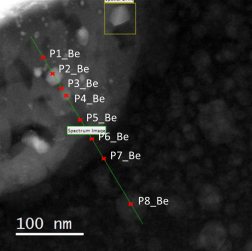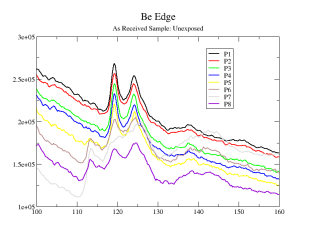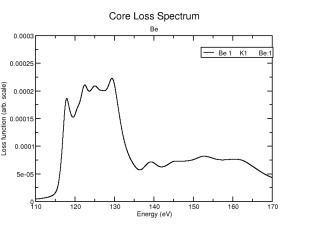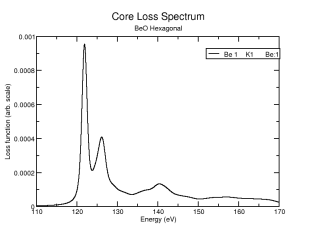Understanding the degradation of Be tiles in the JET tokomak reactor using EELS and DFT
- Abstract number
- 107
- Presentation Form
- Poster Flash Talk + Poster
- DOI
- 10.22443/rms.mmc2021.107
- Corresponding Email
- [email protected]
- Session
- Stream 1: EMAG - Energy and Energy Storage Materials
- Authors
- Mr. Xinlei Liu (1), Ms. Carmen Makepeace (1), Dr. Rebecca Nicholls (1), Prof. Sergio Lozano-Perez (1), Prof. Jonathan Yates (1)
- Affiliations
-
1. University of Oxford
- Keywords
JET tokomak reactor, degradation of beryllium, EELS, DFT
- Abstract text
Beryllium metal is used as a plasma-facing component for the International Thermonuclear Experimental Reactor (ITER) first wall due to its limited reactivity with hydrogen isotopes and good oxygen gettering ability [1]. In the Joint European Torus (JET) tokamak, beryllium tiles are subject to both power and particle loads [2]. The erosion involves 2 major mechanisms: formation of oxides over its surface when exposed to air and deuterium retention during the co-deposition of hydrogen isotopes with beryllium atoms from the edge plasma [3].
To understand the corrosion mechanism of the materials, it is vital to discover the structures of the corrosion products. However, the exact structure cannot be determined from diffraction methods as the selected beryllium oxide area involves more than one structure. In this work, we use a combination of experimental and simulated electron energy loss (EEL) spectra to determine the reaction produces. EEL spectra, both in the low-loss and core-loss regime, of seven candidate structures Be, BeH2, α-Be(OH)2, β-Be(OH)2, α-BeO, β-BeO, and BeO2 are calculated using density functional theory (DFT). For each structure, we performed three calculations: lowloss, Beryllium K-edge and Oxygen K-edge of EEL spectra. The DFT calculations have been performed using the CASTEP code [4]. The PBE functional was selected and ultrasoft pseudopotentials were used in the calculations.
(a) (b)
(c) (d)
Figure 1: (a) STEM image showing region of EDX maps of an as-received JET Be sample, unexposed to H plasmas. (b) Experimental Be K-edge EEL spectra of the sample. (c) Simulated Be K-edge of EEL spectra of beryllium metal. (d) Simulated Be K-edge of EEL spectra of α-BeO (Hexagonal)
As shown in Figure 1, there are distinctive features in the EEL spectra simulated for different materials. By comparing calculated and experimental EEL spectra, we see features proving the existence of Be metal and polymorphs of BeO. EEL spectrum at point 8 matches the simulated one of Be metal while EEL spectrum at point 1 corresponds to α-BeO (Hexagonal). Further confirmation was done for the oxygen K-edge and the low-loss EEL spectra.
The simulated spectra are compared with five sets of experimental data: standard, as-received, deposited, eroded, and melted. The standard samples were used as bench marks to verify if the simulated results were accurate. The as-received sample corresponded to a piece of beryllium metal which was not subjected to any nucleation reactions and corroded at room temperature. The remaining three samples came from different parts of JET tokamak. When comparing the simulated and experimental results, shapes and relative positions of the peaks of EEL spectra of different materials were used to identify the exact structure of the samples.
- References
- [1] Beal, J. M. (2016). Erosion, deposition and material migration in the JET divertor with carbon and ITER-like walls. University of York.
- [2] Roth, J., Doerner, R., Baldwin, M., Dittmar, T., Xu, H., Sugiyama, K., Reinelt,M., Linsmeier, Ch., Oberkofler, M. (2013). Oxidation of beryllium and exposure of beryllium oxide to deuterium plasmas in PISCES B. Journal of Nuclear Materials, 438, S1044–S1047.
- [3] Makepeace, C., Pardanaud, Roubin, P., Borodkina, I., Ayres, C., Coad, P., Baron-Wiechec, A., Jepu, I., Heinola, K., Widdowson, A., Lozano-Perez, S., J.E.T. Contributors (2019). The effect of Beryllium Oxide on retention in JET ITER-like wall tiles. Journal of Nuclear Materials, 19, 346-351.
- [4] Clark, S. J.; Segall, M. D.; Pickard, C. J.; Hasnip, P. J.; Probert, M. J.; Refson, K.; Payne, M. C. (2005). First principles methods using CASTEP, Zeitschrift fuer Kristallographie, 220 (5-6), 567-570




